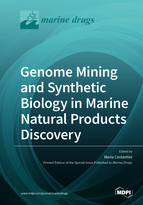Genome Mining and Synthetic Biology in Marine Natural Products Discovery
A special issue of Marine Drugs (ISSN 1660-3397).
Deadline for manuscript submissions: closed (30 October 2020) | Viewed by 26340
Special Issue Editor
Interests: genomic/transcriptomic; marine biotechnology; metabolites in microalgae; nutraceuticals in fish; acquaculture
Special Issues, Collections and Topics in MDPI journals
Special Issue Information
Dear Colleagues,
Oceans cover nearly 70% of the earth surface and host a huge ecological, chemical and biological diversity. The natural conditions of the sea favored the production of a great variety of novel molecules with a great pharmaceutical potential in marine organisms, which are unique for their structural and functional features respect to terrestrial ones. Innovation in the field is going hand in hand with the funding of several FP7 and H2020 projects projects under the topic “Blue growth”, with the common final goal to achieve a more environmentally-friendly approach to drug discovery to overcome negative impacts on the environment linked to the over-utilization of marine resources and the use of destructive collection practices.
Driven by the rapidly decreasing cost and increasing throughput of DNA sequencing technologies, significant progress in genomics has renewed interest in natural product discovery. Rapidly expanding genomic and metagenomic datasets reveal a vast number of biosynthetic gene clusters (BGCs) in nature, which are predicted to encode novel biomedically relevant molecules. This ‘top-down’ discovery approach can only provide to access to a small fraction of biosynthetic compounds, given that majority of microorganisms cannot be isolated or cultured. Furthermore, even in culturable organisms, the encoded secondary metabolites of many biosynthetic gene clusters are unknown. This may be due to strong down-regulation of product biosynthesis at the transcriptional, translational and/or post-translational levels in the absence of the right activating cues in the laboratory. Alternatively, secondary metabolites that are produced at very low yields may escape detection and characterization. Natural product discovery, which used to be predominantly an analytical chemistry problem, has become a challenge in genomics and molecular biology on how to manipulate relevant genes and sequences to produce the desired encoded metabolites.
Dr. Maria Costantini
Guest Editor
Manuscript Submission Information
Manuscripts should be submitted online at www.mdpi.com by registering and logging in to this website. Once you are registered, click here to go to the submission form. Manuscripts can be submitted until the deadline. All submissions that pass pre-check are peer-reviewed. Accepted papers will be published continuously in the journal (as soon as accepted) and will be listed together on the special issue website. Research articles, review articles as well as short communications are invited. For planned papers, a title and short abstract (about 100 words) can be sent to the Editorial Office for announcement on this website.
Submitted manuscripts should not have been published previously, nor be under consideration for publication elsewhere (except conference proceedings papers). All manuscripts are thoroughly refereed through a single-blind peer-review process. A guide for authors and other relevant information for submission of manuscripts is available on the Instructions for Authors page. Marine Drugs is an international peer-reviewed open access monthly journal published by MDPI.
Please visit the Instructions for Authors page before submitting a manuscript. The Article Processing Charge (APC) for publication in this open access journal is 2900 CHF (Swiss Francs). Submitted papers should be well formatted and use good English. Authors may use MDPI's English editing service prior to publication or during author revisions.
Keywords
- Gene clusters
- Secondary metabolites
- Metagenomics
- environmentally-friendly approach







